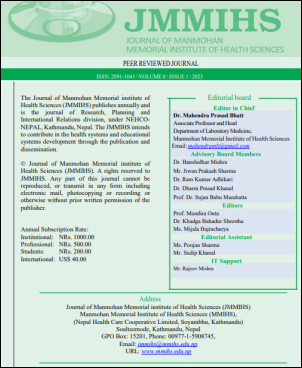Pharmacotherapeutic Management of Pressure Wound in Sushma Koirala Memorial Hospital
DOI:
https://doi.org/10.3126/jmmihs.v8i1.57270Keywords:
Pressure ulcers, Sacral region, Ceftriaxone, Fentanyl, Paracetamol, IbuprofenAbstract
Background: Pressure ulcers are the serious kinds of wounds that get developed within the skin tissues. They affect larger surface areas of the body resulting severe pain in the infected body parts of the patients. Pressure wound, thus has been presented as one of the major health problem worldwide. This study was aimed to find out different aspects of pressure ulcer cases and outcomes in Sushma Koirala Memorial Hospital (SKMH). Along with this, the study was targeted to study major affected body part, role of diet in healing wounds, grades of pressure ulcers and medicines used during the management and treatment of such chronic wounds.
Methods: A descriptive, unicentric, retrospective study was conducted in 2018 at Sushma Koirala Memorial Hospital. A total of 163 patient records from October 2016 to October 2018 were reviewed. The data was entered in SPSS 16 version for analysis.
Results: Pressure ulcers were common among people from the age group 21-40 years. The males were more vulnerable than female. Most people stayed for 41-60 days while the most affected body part in many patients was the sacral region. Third grade sacral region pressure wound was mostly found in the admitted patients. Wounds and injuries were common cause for development of pressure ulcers. The usage of third generation cephalosporin- ceftriaxone was predominantly found during surgery as well as post-surgery. During surgery, most commonly used medications include fentanyl, paracetamol, midazolam and propofol. After surgery, analgesics like ketorolac, combination of ibuprofen and paracetamol were frequently used. For post-surgical condition, ceftriaxone, ascorbic acid, ranitidine and pantoprazole were mostly used. Patients with pressure ulcers were advised to take high protein diet.
Conclusion: This study showed sacral region was most affected body part and grade 3 pressure wound were predominant in most of the admitted patients. Ceftriaxone was mostly prescribed antibiotics and combination of paracetamol and ibuprofen was mostly prescribed for analgesic effects.
Downloads
Downloads
Published
How to Cite
Issue
Section
License
© Journal of Manmohan Memorial Institute of Health Sciences (JMMIHS)
All rights reserved to JMMIHS. Any part of this journal cannot be reproduced, or transmitted in any form including electronic mail, photocopying or recording or otherwise without prior written permission of the publisher.




